WOMEN
PHOTOGRAPHERS
FROM OTHER COUNTRIES AND CULTURES
by
Patrizia Pulga 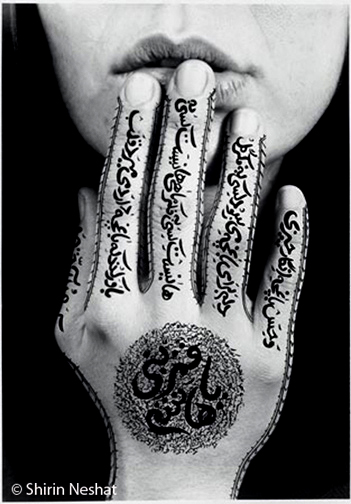
Recently
a lot of women artists coming from Africa and the Middle East are achieving greater
success day by day. Some of them are from Iran, such as the well known actress
Golshifteh Farahani, who played the film “About Elly”, winner of the
Silver Bear in Berlin Film Festival, and Shirin Neshat
who won the Silver Lion at the 66th Venice Film Festival for her directional debut
"Women without Men".
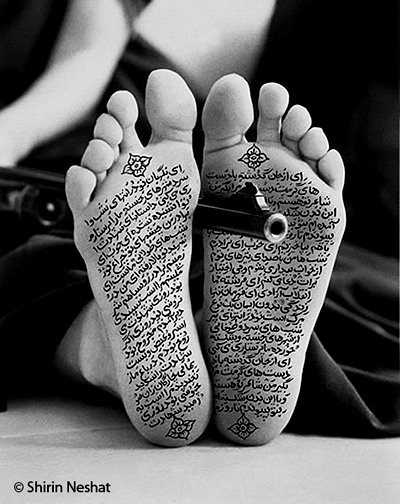
Shirin
is primarly known for her work in films, videos and photographies and she is considered
the first Iranian artist to achieve an international success. Born in Qawzin
(Iran) in 1957, she moved to U.S.A. to study art when she was still very young,
at the beginning of the Islamic Revolution in her country. As a photographer and
video-artist, Shirin Neshat is recognized for her brilliant portraits of women
covered with Persian calligraphy displaying verses of love and loss written by
women Persian poets (notably through the “Women of Allah series” in
1990). She also directed several videos, such as “Anchorage” (1996),
“Shadow under the Web” (1997), “Turbulent” (1998) and
“Soliloquy” (1999).
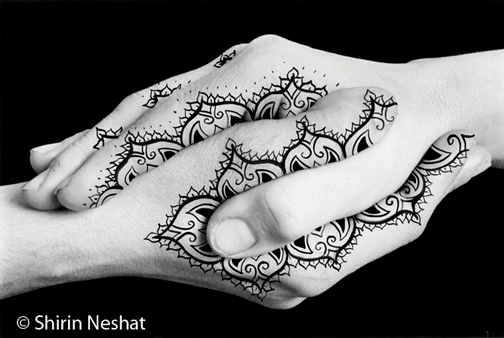
Neshat's
work refers the social, political and psychological dimensions of women's experience
in contemporary Islamic societies, to the codes of Muslim culture and the complexity
of certain oppositions, such as man and woman. Although she actively opposes stereotypical
representations of Islam, her artistic objectives are not explicitly polemical.
Instead, her work recognizes the complex intellectual and religious forces shaping
the identity of Muslim women throughout the world.
“VEILED
MEMORIES” is the title of the exhibit of the XIV Edition of WOMEN'S BIENNAL
EXHIBITION in Ferrara, Italy, in Palazzo Massari, Museum of Contemporary Art.
This year the exhibit ( open April 18 - June 13 2010) has been dedicated to Iranian
women artists: Shirin Fakhim, Ghazel, Firouzeh Khosrovani,
Shadi Ghadirian, Mandana Moghaddam and Parastou Forouhar.
The
exhibit, curated by Silvia Girelli, has been organized
by U.D.I.
(Unione Donne Italiane , Union of Italian Women) with the collaboration
of the Museums of the town. Several artists show films, video or installations,
whereas Mandana Moghaddam, Parastou Forouhar and Shadi Ghadirian use photographs
as medium to document women’s condition in one of the most conservative
countries of the Middle East.
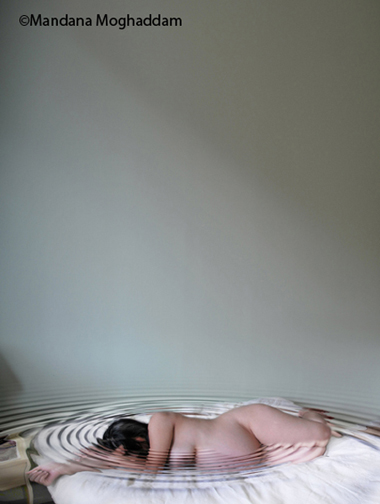
Mandana
Moghaddam was born in Theran in 1962 but actually she lives in exile in
Goteborg, Sweden. Photographer and artist, she has got a lot of scholarships in
Sweden and her works have been exhibited in many European museums and galleries.
The series of the pictures exhibited named “Manije” finds inspiration
in her pregnancy and refers about the intimacy and the solitude of a woman in
her bedroom, broken by a sensation of danger: water is slowly submering the sleeping
woman.In 2005 Mandana, together with Bita Fayyazi Azad, showed her works in the
Iranian Pavillon in 51th “Biennale di Venezia”, curated by the director
of Teheran Museum of Contemporary Art.
Parastou Forouhar
was born in Teheran in 1962, studied art at the University of her native
town with a degree in Art, then, since 1991 she has continued her studies in Germany.
Actually she lives in Frankfurt. She has been awarded many scholarships in Germany
and in Italy.
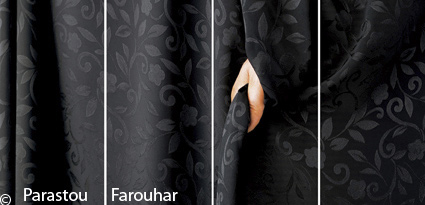
For
“Veiled memories” Farouhar has chosen to exhibit some big pictures
of the black veil used by Iranian women. There is a beautiful tryptich which shows
a woman’s hand as the only visiblepart of her body emerging from the black
dress.
Since
the end of the Nineties she has been urgently furthering democracy in Iran: her
parents were murdered in Iran in November 1998. In her quest for clarification
she went to Iran many times, questioned functionaries in the ministries responsible,
held press conferences and has written letters to human rights organisations and
politicians. There has been no clarification yet.
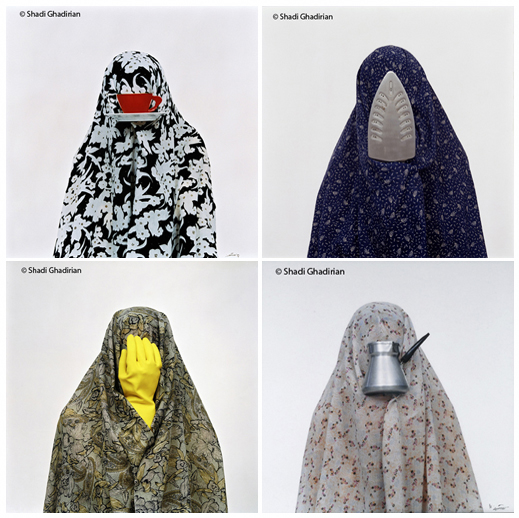
Shadi
Ghadirian was born in 1974 in Tehran, where she still lives and works.
Shadi began her professional photography career after studing photography at Azad
University. Through her work Shadi has always been inspired to create work reflecting
what she sees as the duality and contradiction of life, questioning the role of
women in society and exploring ideas of censorship, religion, modernity, and the
status of women. Ghadirian is the photo editor of Women in Iran website (www.womeniniran.com)
and manager of the first Iranian photography site (www.fanoosphoto.com).
Shadi
made her “Like Every Day Series”, exposed in the exhibit, to show
the daily repetitive routine to which many women find themselves consigned and
by which many women are defined. (see above) Her work has been exhibited in museums
and galleries in Europe, and U.S.A. She has also been featured in print and electronic
media (including the New York Times, Photography Now, the Daily Telegraph, the
BBC and others).
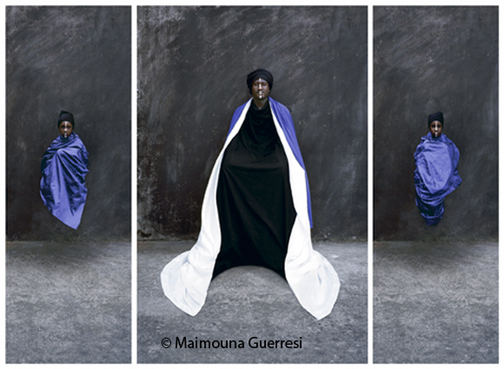
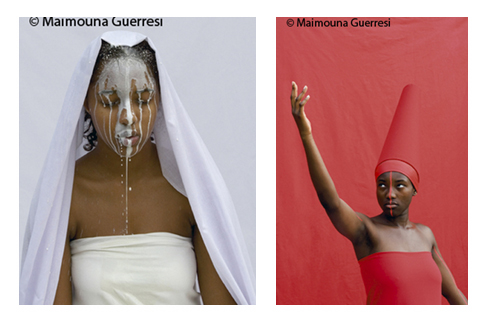
Ghadirian's
pictures actually are part of another very important exhibit
in New York named “BARAKAT: THE GIFT”, curated by the Italian Gaia
Serena Simionati, that includes paintings, sculptures, sound and video installations,
works on paper and photos from nine important contemporary artists: the Egyptians
Moataz Nasr and Hamdi Attia, the Iranians Navid Azimi Sajadi, Shadi Ghadirian
and Reza Derakshani, the Iraqui Halim al Karim, the Libanese Nabil Nahas, the
Turkish Baris Saribas and the Italo/Senegalese Maimouna
Guerresi, (I noted in the previous report about African
Women Photographers).
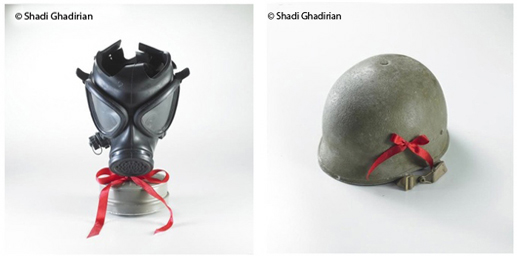
Shadi
exposes some pictures of the series “White Square”: instruments of
war such as helmets and anti- gas masques with a red ribbon, as ironic symbols
of the daily war in her country, while Maimouna gives her contribution with some
pictures of the series “Oracles”. All the artists were chosen for
their strength and poetical approach to the theme of dialogue between different
cultures, acceptance, identity, transformation, through the essence of their art.
The
exhibit is focused on the meaning of the word "Barakat," in Arabic:
Blessing. In a more vast meaning: the Gift, a word which acts like a bridge since
it has different meanings in the Iranian, North African, Jewish and Arabic culture
and in France too where, through the Arab people presence, it has taken the meaning
of Luck.
At STUX GALLERY
530 West 25th Street New York NY 10001
Opening Reception:
June 3 - September 11 2010 (6 - 8 pm)
http://www.stuxgallery.com/
photographers
Shirin Neshat,
Mandana Moghaddam, Shadi Ghadirian,
Parastou
Forouhar, Maimouna Guerresi, Patrizia Pulga
All phtographs © copyright the photographers.
|
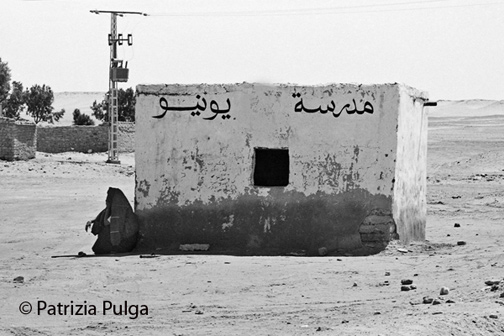
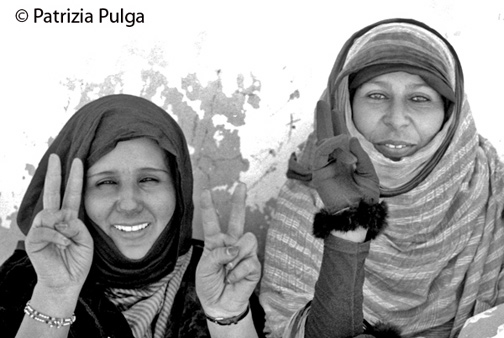
All
rights reserved
copyright WomenInPhotography.org
|










